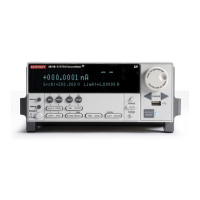8-16 Return to Section Topics 2600S-901-01 Rev. C / January 2008
Section 8: Source-Measure Concepts Series 2600 System SourceMeter® Instruments Reference Manual
Source I measure I, source V measure V
The SourceMeter can measure the function it is sourcing. When sourcing a voltage, you can
measure voltage. Conversely, if you are sourcing current, you can measure the output current. For
these measure source operations, the measure range is the same as the source range.
This feature is valuable when operating with the source in compliance. When in compliance, the
programmed source value is not reached. Thus, measuring the source lets you measure the
actual output voltage.
Basic circuit configurations
Source I
When configured to source current (I-Source) as shown in Figure 8-11, the SourceMeter functions
as a high-impedance current source with voltage limit capability and can measure current (I-Meter)
or voltage (V-Meter).
For 2-wire local sensing, voltage is measured at the Input/Output terminals of the SourceMeter.
For 4-wire remote sensing, voltage is measured directly at the DUT using the sense terminals.
This eliminates any voltage drops that may be in the test leads or connections between the
SourceMeter and the DUT.
The current source does not require or use the sense leads to enhance current source accuracy.
With 4-wire remote sensing selected, the sense leads must be connected or incorrect operation
will result.
Figure 8-11
Source I conf
Remote
SENSE HI
IN/OUT HI
Remote
IN/OUT LO
I-Source
x1
V-Meter
SENSE LO
Local
Local
GUARD
+
I-Meter
NOTES:
1. This represents a protection circuit that is very
high impedance until the voltage across it exceeds
approximately 3V. Above 3V, the protection turns
on and allows current to flow through it.
2. Approximately 13kW.
1
2
2
1
Feedback
iguration

